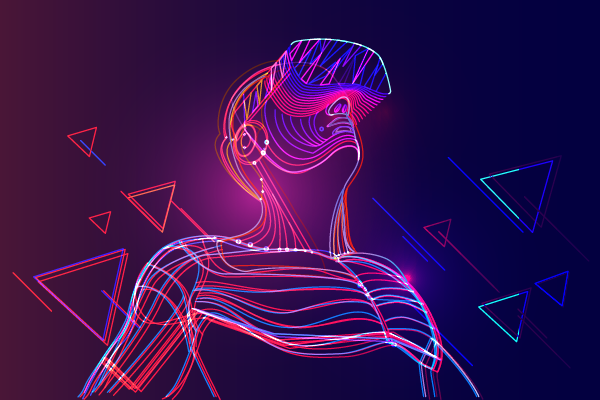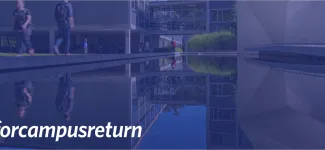Our #readyforcampusreturn series sheds light on the incredible IT teams working behind the scenes to support UBC's transition back to campus. Part five of our series is a joint Q&A with our IT Service Centre and Learning Technology (LT) Hub. We chatted with UBC EML Executive Producer Saeed Dyanatkar and Lab Supervisor Catherine Winters on how they are getting ready re-open their doors this fall.
Q&A with UBC EML
Thank you for joining us. Tell us about how your team has been getting ready to welcome back students, faculty, and staff.
Catherine: What we’ve been doing is making sure we are following the University’s guidelines. In terms of prepping to reopen, we are using things like UV sterilization tools for our headsets. We are making sure that when it comes to things like scheduling, all of our student workers are adhering to the rules about how long they are allowed to be in the lab, where they are allowed to be in the lab, and of course, we are following the mask mandate.
Saeed: There are a number of students who work with us either full-time as Co-op students or part-time as Work Learns. One advantage for EML in terms of COVID-19 safety planning is that we have three different locations on campus, which is handy because we can spread people out throughout the units. When students come in, they will be assigned to different stations. So that is one way we have ensured social distancing.
And as Catherine says, we work with devices that you have to put on your face like VR goggles. We invested in a UV device that we can put headsets into to sanitize them, and then they can be passed to the next person.
What are some projects you’d like to share with the UBC community this Fall? How have your major projects been impacted by having to switch between remote and in-person work?
Catherine: Our project selection would have been the same regardless of working remotely or in-person. We have chosen projects that make more use of server resources rather than someone needing to have a high-powered computer that can run Unity and all the latest and greatest. This also means we don’t need to have people remoting into a high-powered machine. The projects we’ve chosen are flexible in terms of who needs to be working in-person and who can work from home.
Saeed: We have one project in-progress called Virtual Co-Locator. The idea is to bring people who are interacting together virtually and elevate the online working experience. We started in the summer and that was a response to the fact that people are in different locations trying to collaborate.
“We learned how necessary it is to be agile and nimble. This was an easy task for EML. Since our inception we have been evolving. We use the metaphor at EML of a plane that is flying as we build it at the same time."
Executive Producer Saeed Dyanatkar
Then there is the 3D Learning Project, a collaboration between UBC Studios and EML. This project captures specimens, creating 3D models for instructors to use in class and students to use as reference materials outside of class. We started the project before the pandemic, but during the pandemic we realized how important it was for students to have access to virtual space and virtual objects. Earlier last year, everyone was in a panic mode transitioning to a virtual space. Everyone who needed this system didn’t have time for it. But now we are getting more requests to capture objects and specimens into 3D – and that’s hopefully something that will stay as a new service for the university.
Finally, we had to pivot some of our immersive media projects. For example, we were working on a project called Fossa Finder. The idea with Fossa Finder is that an instructor would use VR in the classroom and act like a tour guide and take the whole class with them in VR that students could view on a screen. Because there was no classroom, we had to pivot halfway through the pandemic and change to a 2D representation on a 3D screen. This was not what we were aiming for, but actually helped to make these projects more accessible – which was one of those surprises that made the project even better.
It sounds like the EML always has a fireproof business model, which makes sense as a tech hub always being one step ahead.
Saeed: Even though our work processes have shifted to give students more flexibility, the selection of projects has not really been affected by the pandemic. We use our Faculty-in-Residence teams to go through all the proposals that come in. Projects are considered based on input from our technical teams and the Faculty-in-Residence teams for relevance and the necessity of the final product for teaching and learning.
What is one of the biggest takeaways you’ve learned from the past pandemic year and a half?

Saeed: We learned how necessary it is to be agile and nimble. This was an easy task for EML. Since our inception we have been evolving. We use the metaphor at EML of a plane that is flying as we build it at the same time. The past year wasn’t a surprise for us. It was challenging in terms of logistics, but overall, it was much easier to absorb the transition to virtual as opposed to other things.
Catherine: For me, what really stands out is that we’ve determined what actually needs to happen in person and what doesn’t, and importantly we’ve learned a substantial portion of our student workers prefer one way or another. There weren’t a lot of our team members who were ambivalent about going back. Making sure those needs are accommodated is something we’ve learned and rolled with. For the most part, our student workers are all happy to be here.
How about your clients? How are you getting the word out to them that EML is open to the public again?
Saeed: We are using our social media channels. And there are a group of faculty and staff who are already in touch with EML so we are letting them know we will be back. Hopefully this story also helps!
I hope so too. Finally, is there anything you’re doing differently now that you’ll continue to do after the pandemic?
Saeed: As Catherine mentioned, one of the objectives of EML is student learning and experimental learning. Before the pandemic we required all paid students to be at the lab while they were working. Physical presence was mandatory. That requirement is more flexible now, so students are not required to be in the office all the time, and that is a positive response to what has happened in the world.
Thanks for the great interview. Good luck with your re-opening. We cannot wait to visit the lab soon ourselves!
Useful links
Enjoyed this story? Check out our other #ReadyforCampusReturn stories below:
/**/ .story_text { } .no_left { margin-left: 0px!important; margin-right: 15px!important; } .node-news-article .field-name-field-news-article-image { float: left; width: 100%; margin-right: 45px; } /**/



